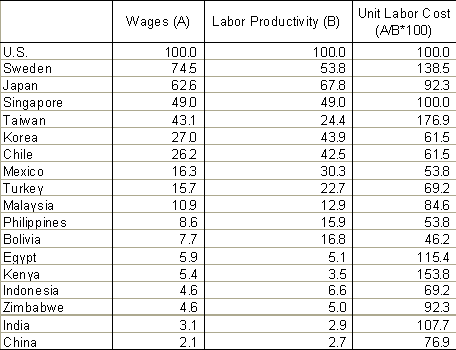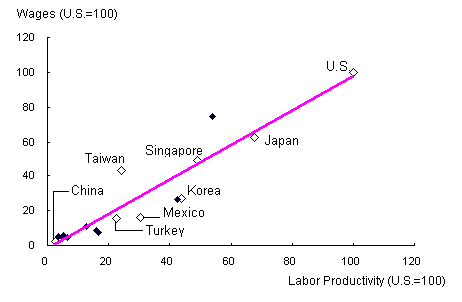It is often said that since the wage levels in China are low relative to industrial countries, products made in China have strong international competitiveness. Among Japanese corporations too, a gloomy mood persists that it is impossible for them to beat their Chinese counterparts in international markets, given the very large wage gap between the two countries. It is certainly true that low wages have been a major factor contributing to China's strong competitiveness in labor-intensive products, but looking at Chinese industry as a whole, they rather reveal its lack of competitiveness. Taking into consideration the fact that Japan's strength lies in technology-intensive products, it is clear that China poses no threat to Japan because the two countries complement, rather than compete with, one another.
It goes without saying that wages alone do not decide the competitiveness of a country's industries. If the simple logic that "low wages equals high competitiveness" were actually true, countries such as Bangladesh and Somalia, with wage levels even lower than those of China, should be competitive. It would also be expected that in China too, foreign investment would be focused on the inland regions of the country where development is lagging behind that of the coastal regions. In reality, however, these trends have not materialized. Accordingly, when making judgments concerning competitiveness it is vital to take labor productivity into consideration. In other words, in countries where wages are cheap relative to productivity, competitiveness should be strong, but in low-wage countries where productivity is even lower, competitiveness should actually be weak.
As an indicator of competitiveness, it would therefore be better to use unit labor cost, which takes into consideration both wages and labor productivity. For example, although the average wage rate in China is only 2.1% that of the United States, productivity is also at only 2.7% that of the U.S., so that its unit labor cost (2.1/2.7 = 76.9%) is not so much different from that of the U.S. ( table 1 ). If other factors such as China's high capital costs, poor infrastructure and weak legal system, are taken into consideration, its advantage in international competitiveness is further diluted.
Since international comparison needs to be measured in a common currency unit (e.g. the dollar), a country's unit labor cost is also affected by exchange rate fluctuations. For example, let us imagine a case in which China, in an attempt to expand exports, devalues the yuan. In dollar terms, the unit labor cost in China would fall and competitiveness would improve as a result. But this would be temporary, and with time domestic prices and wages would increase, thus offsetting any gains made in competitiveness. Reflecting this situation, over the long-term, wage levels basically move in conjunction with labor productivity, and the two do not diverge to a large extent.
In a cross-section comparison among countries at different levels of economic development, there is also a strong positive correlation between productivity and wages ( figure 1 ). Thus in developed countries, high productivity is reflected in both strong international competitiveness as well as high wage levels, while in developing countries, low productivity is reflected in low international competitiveness as well as low wage levels.
The large gap in productivity between China and the developed countries means that, when China participates in the global markets, it can do so only by specializing in labor-intensive products (or labor-intensive processes for technology intensive products) in accordance with its comparative advantage based on low wages. Since China has an enormous surplus of labor in its rural areas, further increase in the demand for labor in manufacturing areas would not result in upward pressure on wage levels. Thus, for the time being, China should have no problem sustaining its competitiveness in labor-intensive products. In these circumstances, however, since for Chinese corporations the optimal strategy is to expand labor input rather than improve productivity, low wages could actually be a factor retarding the advancement of industries.
So long as China depends on low wage levels to compete in international markets, it can at best be a "factory of the world," rather than an "industrial power" that would rule over such high value-added areas as product standards, brand names, and core technologies. Since low wages also imply a low standard of living, no doubt they should be understood as a sign of China's weakness rather than its strength.
Table 1 : Unit labor cost by country: Comparison with U.S.

(Reference) United Nations Conference on Trade and Development (UNCTAD), Trade and Development Report, 2002.
Figure 1 : Wages compared to labor productivity by country

(Source)Plotted on the basis of data in Table 1
- Related article
- Don't Confuse "Made in China" with "Made by China", China in Transition, 26 April, 2002
August 30, 2002
Article(s) by this author
-
“Involutional Competition” Leading to Oversupply in China
―Policy responses based on causes and impacts―October 31, 2025[China in Transition]
-
The Urgent Need for China to Reform its Legal Frameworks on Private Enterprises
- Enactment of the “Private Economy Promotion Law” marks a major step forward -August 4, 2025[China in Transition]
-
Watch Out for the Kindleberger Trap
- International order in turmoil due to a lack of leadership -July 15, 2025[China in Transition]
-
Private Enterprise Roundtable
- Spotlight on Transformative Trends in the High-Tech SectorApril 3, 2025[China in Transition]
-
Outlook for China Policy in the Trump Administration's Second Term
- Concerns over accelerating U.S.-China decoupling -February 7, 2025[China in Transition]


